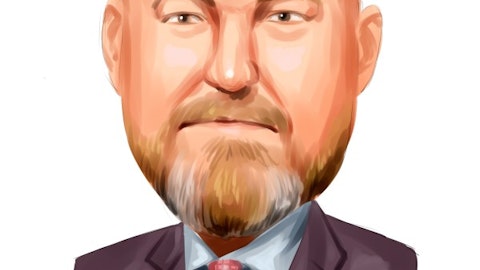Daseke, Inc. (NASDAQ:DSKE) Q3 2023 Earnings Call Transcript November 9, 2023
Daseke, Inc. misses on earnings expectations. Reported EPS is $0.02 EPS, expectations were $0.1.
Operator: Good morning, everyone, and thank you for joining today’s conference call to discuss Daseke’s Financial and Operational Results for the Quarter Ended September 30, 2023. With us today are Jonathan Shepko, Chief Executive Officer and Board Member; Aaron Coley, Executive Vice President and Chief Financial Officer; Scott Hoppe, Executive Vice President and Chief Operating Officer; and Adrianne Griffin, Vice President of Investor Relations and Treasurer. I would like to now turn the call over to Adrianne Griffin. Adrianne, please go ahead.
Adrianne Griffin: Thank you, Kevin. As indicated in the press release earlier today, participants may now download the third quarter 2023 presentation that will accompany the remarks made on today’s call. You may access this presentation on Daseke’s website, www.daseke.com and in the Events and Presentations portion within the Investor Relations section. Slide 2 of today’s presentation contains our Safe Harbor and non-GAAP statements. Today’s presentation also contains forward-looking statements within the meaning of the Private Securities Litigation Reform Act of 1995. Projected financial information, including our guidance outlook are forward-looking statements. Forward-looking statements, including those with respect to revenues, earnings, performance, strategies, prospects and other aspects of Daseke’s business are based on management’s current estimates, projections and assumptions that are subject to risks and uncertainties that could cause actual results to differ materially from our expectations and projections.
I encourage you to read our filings with the Securities and Exchange Commission for a discussion of the risks that can affect our business and not to place any undue reliance on any forward-looking statements. We undertake no obligation to revise our forward-looking statements to reflect events or circumstances occurring after today, whether as a result of new information, future events or otherwise, except as may be required under applicable securities laws. During the call, there will also be a discussion of some items that do not conform to US Generally Accepted Accounting Principles or GAAP, including and not limited to, adjusted EBITDA, adjusted EBITDA margin, adjusted operating ratio, adjusted operating income, adjusted net income or loss.
Reconciliations of these non-GAAP measures to their most directly comparable GAAP measures are included in the appendix of the investor presentation and press release issued this morning, both of which are available on our website. In terms of the structure of our call today, I will first turn the call over to Jonathan Shepko, who will review our business operations and then progress that we are making as we execute our key strategic priorities. Aaron Coley will then provide an update on our third quarter results. Jonathan will conclude our prepared remarks with an updated 2023 outlook before we open the line for your questions. With that, I’ll turn the call over to Jonathan. Jonathan?
Jonathan Shepko: Thank you, Adrianne, and thank you all for joining us this morning. Before I provide our results for the third quarter and outlook for the final quarter of the year, I’d like to thank our team members for their ongoing service to our customers, our vendors, their fellow team members and our company. Thus far, during a challenging year for the transportation and logistics industry, our team has achieved many successes. In fact, we have demonstrated improved performance during the cycle trough, including enhanced operational productivity, successful execution of our 2023 One Daseke initiatives, and the strengthening of our balance sheet. Our collective performance will advance our business for many years to come.
During the quarter, we recorded $98 million total consolidated miles, a two million mile increase over the prior year period with company miles reporting 8.5% growth. In concert with the additional mileage, our organization has taken decisive actions to improve our operating performance. Year-over-year consolidated productivity, as measured by miles per seated tractor per day improved 0.6%. We added 10% to our company tractor fleet and currently improve utilization by 0.6%. Achieving operational improvement is materially more difficult in a softer environment. Thus, these results are a testament to our team’s focused and deliberate execution. Simultaneously, our operating teams have also diligently allocated incremental and higher rate loads to our company-owned fleet for improved margin capture.
We continue to advance our One Daseke initiatives to improve our process and position ourselves for the up cycle. Earlier this year, for example, we launched a new platform that facilitates company-wide visibility for our recruiters to see and share open driving positions across the Daseke organization. With a holistic view of open driving positions, recruiters can efficiently collaborate to guide the best driving talent to the optimal fit anywhere within Daseke. Another encouraging success is the completion of our first phase integrations. In late 2022, we began integrating two smaller operating companies into our largest specialized operating company. At the inception of the integration, the two smaller opcos struggle with higher unseated truck count, operational challenges and commercial opportunities collectively driving each of these companies’ operating ratios to exceed 100%.
Over the last several months, as the benefits of these integrations have begun to offset the friction costs, we have seen a several hundred basis point improvement in operating ratio in a much more challenging environment. And on our August earnings call, we discussed taking actions to integrate an underperforming Southeast flatbed fleet with one of our stronger core Southeast flatbed platform companies. The once underperforming fleet is now delivering margins on par with a stronger platform company, helping to offset some of the continued market weakness. Pro forma for these integrations, the combined operations are improving financial and operational metrics and these integrations have absolutely contributed to improved adjusted EBITDA performance in 2023.
In fact, with these cumulative actions, we are pleased to report achieving the $10 million in adjusted EBITDA contribution we set as a goal for this current year and we would expect this post-integration value uplift to be even more pronounced in stronger market environments. These actions are concrete examples of the strategies we are employing to optimize our operations, improve consolidated performance and deliver strong returns. For our final update on improved performance during the cycle trough, we have firmly adhere to our commitment to enhance our balance sheet, using excess cash to reduce higher cost components of our capital structure, reducing gross debt and lowering ongoing cash costs, which Aaron will now detail in his prepared remarks.
Aaron?
Aaron Coley: Thank you, Jonathan, and good morning, everyone. I will begin with an update on our capital allocation on slide seven. As you will recall, early in 2023, we committed to meaningfully reduce our gross leverage. During the third quarter, we continued to deliver on that commitment by making a $20 million discretionary payment on our term loan, included in this payment, we have now reduced the term loan balance by $73 million in 2023. In addition to redeeming all our preferred Series B-1 shares that carried a 13% annual dividend for $20 million. Together, this $93 million balance sheet improvement was funded with cash on hand. And as of September 30, 2023, our total debt was lower than the balance as of year-end 2022.
If these actions had cumulatively occurred on January 1 of this year, we would have lowered interest expense by $2.8 million and permanently eliminated $2.6 million in annual preferred dividend payments for a total cash savings on an annual basis exceeding $5 million. Given our term loan currently bears interest at 9.5% and the Series B-1 was at 13%, we significantly improved our cost of capital. Our resulting liquidity position was $189 million, including $77 million of cash on hand and $112 million available from our revolver. We will continue to evaluate opportunities for additional outsized term loan repayments, and we intend to remain thoughtful and flexible with our capital allocation, while always considering the improvement of our risk-adjusted return for shareholders.
Now turning to Slide 8. I’d like to review our consolidated Q3 financial performance. As anticipated, the typical seasonal uplift was largely absent and our third quarter consolidated revenue of $402 million was 13% lower than the same quarter last year. While net revenue, which excludes fuel surcharge revenue was $355 million or 11% lower than the prior year period. We continue to see demand growth in logistics, where revenue increased more than 8% year-over-year, which was driven by our strong customer relationships and our focus on leveraging our differentiated capabilities to help customers solve their logistics challenges. During the third quarter, the company recorded a 93% adjusted OR compared to 89% in the prior year period, as operating expenses occurred at reduced at a slower rate than revenue.

Adjusted EBITDA of $50 million was $2 million lower compared to the second quarter of this year, but less than one half of 1% lower on an adjusted EBITDA margin basis, which declined from to 14.1% from 14.5%. That said, as compared to the prior year period, adjusted EBITDA declined $15 million, primarily due to freight rate declines combined with fuel surcharge revenue declines that outpaced the decline in fuel cost in the current year quarter and weakened secondary market for revenue equipment sales. During the third quarter of 2023, company fuel expense, net of fuel surcharge revenue increased by $0.09 per company mile as compared to the same period in 2022. This resulted in approximately $5 million of adjusted EBITDA reduction in the current year period as compared to the prior year period.
While we expect fuel surcharge to be neutral to earnings over the long-term, it lags current market conditions when diesel prices quickly rise or fall. Current quarter adjusted EBITDA was also impacted by lower realized prices on equipment sales, which reduced third quarter 2023 gain on sale by $2 million versus the third quarter of 2022. Realized prices were lower due to additional equipment in the market arising from transportation companies, shedding excess capacity as new orders arrived and carriers that exited. Including consolidated results, we generated cash flow from operations of $34 million in the quarter. This is a sequential improvement versus the $28 million generated in the second quarter and $31 million in the first quarter, which totals $93 million in cash flow from operations so far this year, demonstrating the cash generation power of our business even at freight cycle lows.
Turning now to Slide 10. Our Specialized Solutions segment reported revenue of $239 million, an 11% decline versus the prior year quarter, primarily due to revenue reduction in the owner-operator freight, brokerage and fuel surcharge revenue. In the third quarter of this year, Specialized Solutions realized an average rate per mile of $3.31 compared to the prior year period of $3.62. This decline in rate equates to $12 million of lower revenue on 4 million miles driven during the quarter. Adjusted OR was 92% in the current year quarter compared to the near cycle peak of 87% in the third quarter of last year. This current quarter result is still favorable, considering the current freight environment. Adjusted EBITDA and adjusted EBITDA margin were $31 million and 15% in the current year period.
Current quarter adjusted EBITDA was impacted by increased net fuel expense of $0.09 per mile this quarter, resulting in a $4 million reduction in adjusted EBITDA, as compared to the same period in 2022. Specialized Solutions maintained solid performance versus the prior year period, with total miles, miles per seated truck per day and deadhead essentially flat with the year ago period. Compared to the prior year period, segment company miles were nearly 5% higher and company loaded miles were more than 6% higher. Our team to continue to prioritize loading of higher-margin company-owned assets, resulting in the decline in company freight revenue of less than 2% versus the robust prior period. Moving on to Slide 11. Third quarter 2023 Flatbed Solutions segment revenue of $164 million was $31 million lower than the strong prior year quarter.
However, this is a reduction of revenue — this reduction in revenues was largely contained to the $25 million decline in asset-light revenue between brokerage and owner operator. In the third quarter of this year, flatbed solutions realized an average rate per mile of $2.36 compared to the prior year period of $2.59. This decline in rate equates to a blended $12 million of lower revenue on the 50 million miles driven in the quarter. Adjusted OR was 95% in the current year quarter compared to the near cycle peak of 92% in the third quarter of last year. Adjusted EBITDA and adjusted EBITDA margin were $19 million and 14% in the current year period. Current quarter adjusted EBITDA was impacted by the previously mentioned $0.09 per mile of increased net fuel expense, resulting in a $1.5 million reduction in adjusted EBITDA as compared to the same period in 2022.
Nearly all of the aforementioned $2 million decrease in gain on sale was realized within the flatbed segment. The combined impact of these two trends was $3.5 million, comprising a majority of the $3.9 million comparative period reduction in adjusted EBITDA. To come back to declining rates, flatbed solutions diligently focused on operational excellence. Total segment miles increased 4% versus the prior period to nearly 50 million miles. Ceded truck count was nearly 19% higher and bend from improvements in deadhead and miles preceded truck per day of 1% and 6%, respectively. When combined with the proactive asset right shift toward company capacity, these productivity and utilization improvements overlaid on a 2% higher company seated truck count created an increase of more than 20% in company loaded miles.
This yielded 5% better company freight revenue than the third quarter of 2022, overcoming the soft rate environment and partially offsetting a decline in brokerage revenue. Our asset right strategy continues to support our results through the cycle. And we remain focused on productivity improvements to augment our results now and in the future. This includes the successful integrations Jonathan mentioned in his opening remarks. Our results reflect our team members’ focus on operational efficiency and the strengthening of our balance sheet, which establishes an even stronger position ahead of the impending up cycle. Now I’ll now turn the call back to Jonathan for an update on our 2023 outlook. Jonathan?
Jonathan Shepko: Thank you, Aaron. Turning now to Slide 12. With nine months of the year behind us, our forecast for the remaining months anticipate many of the thematic pressures on financial performance to persist. Inflationary headwinds and oversupplied used equipment market, a restless owner operator and lease purchase driver pool and typical seasonal rate softening in an already challenged environment. We do believe in the adage the cure for low prices is low prices, and this cycle will eventually correct in a meaningful way even without a distinct external catalyst. We will likely not be beneficiaries of this recovery until 2024, however, and as such, we are adjusting our 2023 full year adjusted EBITDA outlook to $185 million to $190 million which implies a fourth quarter of $35 million to $40 million.
Furthermore, we are updating our net capital expenditure guidance to $155 million to $160 million, which is higher than the previous guidance of $135 million to $145 million. This update is largely due to the timing of equipment deliveries based upon delivery delays in the first half of the year and our ongoing discussions with the OEMs. While we were expecting an ongoing lag in 2023 equipment deliveries in recent months, the OEMs have committed to fulfilling our original 2023 orders, and hence, we now expect 2023 reinvestment more in line with our original capital budget of $145 million to $155 million. That said, as discussed in today’s prepared remarks, the secondary equipment market has impacted our cash proceeds, which is also contributing to the now modest increase in our net capital guidance.
As we prepare for the impending up cycle, these expenditures position our company with a younger fleet, which reduces operating and maintenance costs, increases uptime and allows us to attract and retain some of the best drivers in the industry. Our 2024 ambition is to continue to be cash flow positive regardless of the market environment. With that in mind, we intend for our future capital expenditures to have an upper bound within our projected discretionary cash flow, and we will remain focused on deleveraging our balance sheet and holding sacrosanct the durability of our company. Moving on to slide 13. While the freight environment is not cooperating, the macro backdrop is cautious and the capital markets are skittish. We do believe this phase of the cycle will soon pass as it always has.
What I’d like everyone on this call to walk away with today are a few key messages from this slide. First, our significant progress during the last four years as evidenced in part by our sustained peer-leading improvement in adjusted EBITDA margin, inclusive of fuel surcharge since the last cycle trough in 2019. To be clear, the chart on the right side of the slide is a trough-to-trough relative comparison of rolling four quarters adjusted EBITDA margin, inclusive of fuel surcharge revenue, comparing Daseke versus a broad 14-company transportation and logistics peer group. Our margin improvement over this four year period has demonstrated our best-in-class positioning among this Trucking and Logistics Industry Group, while investing nearly all of our truckload peers with trough to trough margin improvement of nearly 32% or 300 basis points, in a more constructive freight market.
We expect this relative outperformance to sustain with an even wider adjusted EBITDA margin spread. Second, in addition to numerous operating company integrations, our progress is clearly validated by our third quarter adjusted OR of 93%, an impressive improvement from 96% in 2019. And our 2023 year-to-date adjusted EBITDA of $150 million is 26% higher than what we generated through the first three quarters of 2019. This significant financial progress, together with our 2023 capital allocation actions, has contributed to improving our gross leverage to 3.3 times from 4.5 times in 2019. The change we are affecting is real and is lasting. We will continue to pull the right levers, deliver on our commitments and priorities and drive additional earnings and free cash flow.
These efforts will provide an attractive runway for our shareholders, extended by the recovery in our sector as well as the eventual multiple expansion, we would expect our stock to benefit from as we perform. We are proud of how we have risen to the occasion and driven the company forward. We are encouraged by the resolve the agility of our team, continuing to provide customers with differentiated service as well as finding new opportunities. The idea of the cycle is pressure testing our businesses, prompting us with an obligation to be dispassionately critical about not only our customers, lanes and subverticals but also our own operating companies. We are taking comprehensive approach focused on improving long-term profitability from reallocating resources out of unprofitable lanes to contemplating elimination of fleets that lack cross-cycle resilience.
We will not take our eye off the ball. I’d now like to ask the operator to open the line for your questions. Kevin?
See also 13 Best DRIP Stocks To Own and 12 Dogs of the Dow Dividend Stocks to Buy.
Q&A Session
Follow Daseke Inc. (NASDAQ:DSKE)
Follow Daseke Inc. (NASDAQ:DSKE)
Operator: Thank you. [Operator Instructions] Our first question comes from Jason Seidl with TD Cowen. Your line is open
Q – Jason Seidl: Thank you, operator. Jonathan and team, good morning, guys. Couple of questions from me here. You’re increasing the CapEx a bit, but reducing your expectations on earnings. It seems a little bit counterintuitive maybe run through that a little bit more for me? And also I know you probably don’t have it out yet for 2024 on CapEx, but at least directionally, what should we expect
Aaron Coley: Yes. Thanks, Jason. Yes, as we look at 2023, we have the opportunity to catch up. And so as we look at 2024, we would expect a lower 2024 net CapEx. We maintained the investment in our equipment and our professional drivers and reduced forecast ahead of the upcoming cycle. And we think — these together lower our operating costs, increase asset reliability and overall better prepare us for the upcoming cycle.
Jonathan Shepko: Yes. And just to add on to that, Jason, I do want to be clear. So our CapEx guide at the beginning of the year was $150 million to $155 million. And so in our prepared remarks, we kind of mentioned, given some of the delays in the OEM deliveries and scheduling, we took that and at the end of the first quarter, we took that down to $135 million to $145 million. The OEMs then told us, I mean, really, in the last kind of — in the last few months that they could actually catch us up — we’ve taken advantage of that to Aaron’s point, we do believe having a younger fleet being well positioned to take advantage of the uptick is the way to go. So our CapEx guide is very close to what it was at the beginning of the year and that Q1 reduction was only given anticipated — only provided only made because we anticipated some equipment delays by the OEMs.
Q – Jason Seidl: Okay. That makes sense. And you said the guide for net next year is going to be down. Is the guide for growth going to be down as well?
Jonathan Shepko: Yes. Yes.
Q – Jason Seidl: Okay. Perfect. Okay. You guys also talked about not expecting to see a turnaround until 2024. Can I get you to narrow that? Do you expect — is it going to be first half or second half for you guys?
Jonathan Shepko: Yes. We — I mean, look, hard to say. I mean we’ve listened to some of the other — our other peers kind of talk about it. And I think we’re thinking about 2024 the same way where it’s going to be, I think, the word transition year has been used to describe next year quite a bit. And if you think about things from a rate standpoint, you look at a source like FTR who’s predicting spot rates to firm back up next year. Look, that’s great for us. It’s great for the industry. It also means that contract rates are not far behind maybe a couple of quarters behind that. So, when you think about the rate side of the ledger, we’re cautiously optimistic there. Early discussions we’ve had as we go into bid season with our larger core customers, suggest that contract rates are going to be flat to this year.
I think as we get to the back half of the year, we might have — we might see some kind of movement there and maybe we get a little bit of gain a little bit of ground with some of those customers. So, we think that we think all in all, the rate side of the ledger is going to be fairly balanced, fairly stable. The volume side of the ledger, we think is going to be interesting. We do think that the industry has talked about capacity leaving the market for a number of quarters now. We do think that we’re at a point within the next few quarters where that will start to have a more meaningful impact and really bringing supply/demand in parity. And I think the other big shift that you’re seeing there the carriers leaving aren’t the one truck, five truck, 10 truck carriers anymore, fleets anymore.
They’re the 100, 200, 300, 400 truck fleets that are exiting the market. So, we think that as that phenomenon continues, you’ve got some of the larger brokerage houses coming closing down, you’ve got some of the — a number of the asset-light logistics shops, closing up shop. So, as you really begin to take — continue to take that capacity out, particularly in those larger swaths, we’ll start to see a little bit of parity. We think that will help. And the other thing that I think we can speak to on the volume side is we are starting to see kind of a flight to safety, if you will, of our customers. 2021, 2022, there was kind of a reallocation of volumes in favor of broker — in favors of kind of the broker shops and the asset-light guys, right, because they had a kind of value proposition in lower rates relative to contract rates.
What we’re seeing now is a number of those carriers are going out of business. A number of those carriers can’t cover the loads when they get them. So, they’re double brokering, triple brokering those loads. Shippers are losing visibility as to actually who’s moving those loads. Cargo claims are up dramatically. On-time delivery service generally is dramatically waning. And so we do think that as these more sophisticated shippers look at the universe, look at the kind of financial fallout and the risk to managing and continuing their business and operations, they’re going to ship some of that transport spend in favor of the asset-light asset-based guys, and so we’ll be beneficiaries of that on the volume side. And then I think what we’ve got we’ve got our transformation, which we have said $10 million.
We still $10 million next year. We still feel really good about that. And then you’ve got — look, you’ve got an election year. So — it’d be interesting to see what the Fed does as we approach that, if anything. So, there could be a catalyst there to improving the environment. We certainly think that depending on which regime wins next year, there could be a more — look, a friendlier group in control, that would be very beneficial to a lot of the end markets that we serve. So, there’s a lot I think to be excited about next year, but we’re still putting our numbers together for 2024, but we’re — I think we’re cautiously optimistic that it will be a transition year plus with potentially a little bit of upside to this year.
Q – Jason Seidl: Okay. Well — given that backdrop and given the backdrop for lower CapEx, you’re going to generate additional cash next year. You’ve done a very good job of debt repayment with a $50 million slug and a $20 million slug, what should we expect going forward? And has there been any consideration to doing a buyback? I know you guys aren’t the most liquid am out there, but being slightly less illiquid than you are now, probably will have a very little impact.
Aaron Coley: Yes. So a fair question. I mean, I think, that I’ll hit the share buyback first and then I’ll talk about leverage to this. I think the way we’re thinking about the share repurchase, I definitely think it’s on the table something we talk about amongst the management team, frankly, daily, particularly at this price and with the Board pretty regularly as well. So I do think that we’ll earmark some amount of cash for a repurchase. I can’t tell you the repurchase is going to take place in the next month or six months, but certainly would like it to take place in this kind of stock price ZIP code before the market starts to price in kind of a recovery and the stock tiers. So we do want to buy kind of in this area. So I think something in the near term is definitely on the table.





